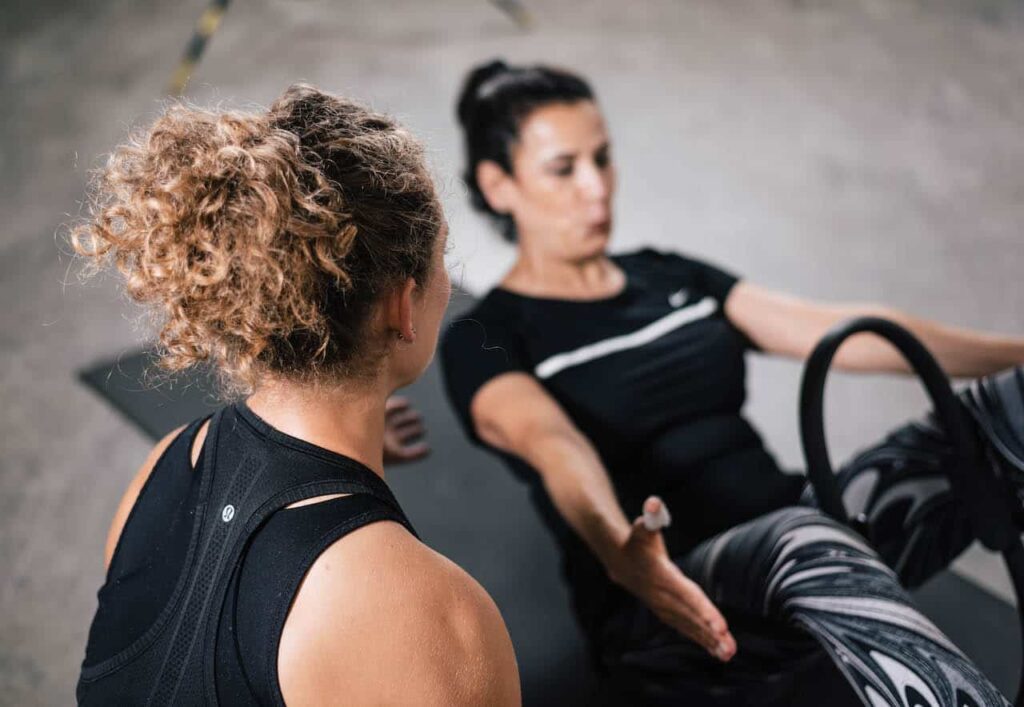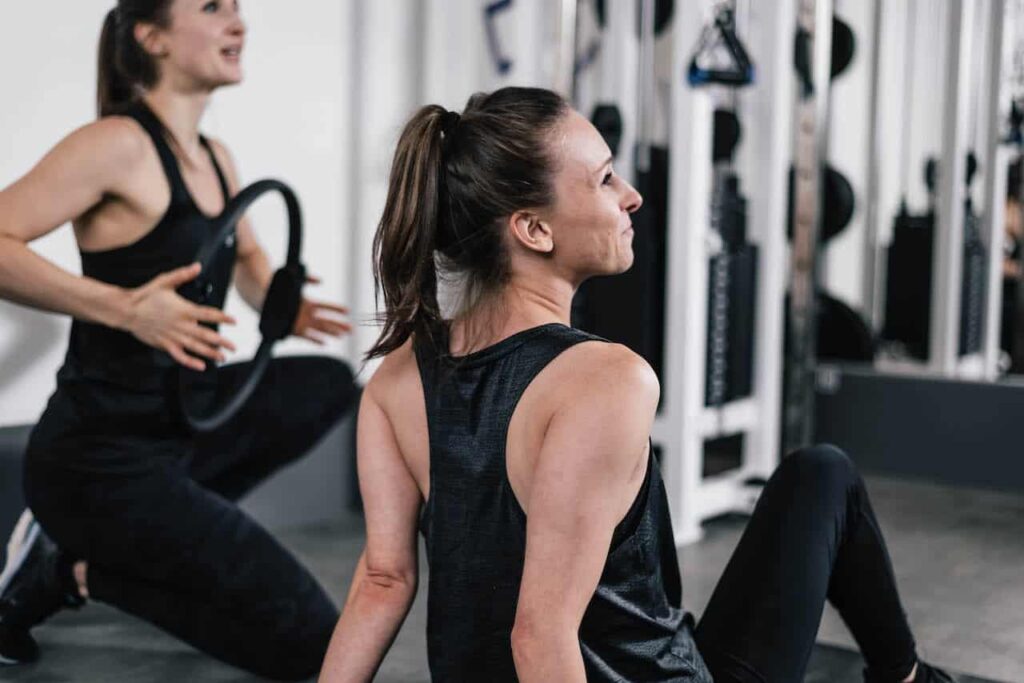There’s plenty of evidence to suggest that exercise can help to alleviate many of the symptoms of the menopause – but the term ‘exercise’ is quite vague. Without in-depth research, it can be hard to say whether you should be lifting weights, taking part in yoga classes, getting plenty of steps in each day – or slogging it out on a treadmill.
We’ve looked at the benefits of strength training through the menopause elsewhere – but what about cardio?
Here, we’ll take a detailed look at cardio during the menopause – including what it might offer, the different types of cardio, and what a programme might look like for someone at any stage of the menopause.
What is the menopause?
Menopause is the natural ceasing of the menstrual cycle, and presents once a person has not had a cycle for at least 12 months.
Perimenopause – meaning ‘around menopause’, is the transitional phase between a regular menstrual cycle and menopause.

The age people reach menopause is dependant on many variables, from genetic to lifestyle. It’s understood the average age is close to 52 years old.
In reality, the actual age people reach menopause deviates greatly from this average. In some instances it starts significantly younger, between one and three percent of people experiencing menopause below the age of 40.
Symptoms can be unpredictable and vary from psychological to physical. The experience is extremely individual and there is no room for one size fits all advice on how to manage/ alleviate symptoms!
Common psychological symptoms experienced during menopause include:
- Mood changes
- Fatigue
- Decreased libido
- Anxiety
- Depression
- Common physical symptoms experienced during menopause include:
- Increase in weight and body fat
- Pelvic floor function
- Reduction in bone mineral density
- Sleeplessness
- Cardiovascular disease (CVD)
The notorious villain of the menopausal period is undoubtadly estrogen.
A significant drop in levels is often blamed for weight & body fat gain, and a big reason people opt for Hormone Replacement Therapy (HRT).
However, recent studies focusing on the effect of HRT on alleviating menopausal symptoms showed that fat gain was the same between the HRT group and non HRT group.
This suggests that the reason for body fat & weight gain is age related and not due to menopause. Many people report experiencing rapid redistribution of body fat to the abdomen area, further creating the association of instant body fat gain during menopause!
However, this is simply redistribution from hip area to abdomen, not an actual gain in body fat.
There are many schools of thought as to how best to alleviate symptoms. Although, whichever you decide to follow, the core focus should be on your wider health and wellbeing. Not just fixing surface level issues.
What is cardio training?
Cardio training has a cool reputation these days, nobody sits on an exercise bike for 2 hours anymore. We have access to spin, group exercise classes and combat fit to name a few.

But what exactly is meant by cardio training, now it has so many different forms?
Cardiovascular training (cardio) refers to any physical training to strengthen your heart and increase your lung capacity. As this improves, so do many other health markers.
So what type of cardio should you choose?
We suggest you choose a type of cardio training that makes you feel better, not worse! It’s good to push yourself and work hard, but remember the goal is to make improvements, not run yourself into the ground.
Why does cardio training help during the menopause/peri-menopause?
Cardio has been documented to have positive effects on physical health, as well as mental health. So regardless of if you’re experiencing menopause it’s advisable to include it in your exercise regime.
Most forms of cardio will fit under one of three headings, each describing the way the exercise is carried out.
Low Intensity Steady State (LISS)
Low Intensity Steady State (LISS) cardio refers to cardio sustained at a continuous low output. A conversational pace row, or cycle on the exercise bike lasting anywhere from 45 – 60 minutes.
Moderate Intensitity Steady State (MISS)
You guessed it, moderately more intense than the talking pace. This is more likely to fit a dance exercise class lasting between 30 & 45 minutes.
High Intensity Interval Training (HIIT)
Probably the most popular form of cardio, HIIT promotes quick weight loss results and defined muscles. Based around very intense bursts of energy lasting 30 – 45 seconds followed by a short rest, repeated for rounds or time. With such high intensity also comes the need for a huge amount of recovery.
Recovery is often glanced over, meaning people experiencing stress could risk making this worse by pushing themselves too hard with exercise. Even with the best intentions.
Assuming you strike the right balance, the benefits during menopause are very desirable.
Cardio Effect On Heart Disease
Frequent exercise is strongly associated with a decrease in cardiovascular mortality and significantly lessens the risk of developing cardiovascular disease.
Having a strong base of cardio fitness that allows you to work out regularly will reduce these risks.
Regular aerobic exercise conditions your heart and lungs to function for a long period of time. It also helps your heart use oxygen better and improves blood flow. This can be great for feeling more energised throughout the day.
Cardio Effect On Depression & Stress
The release of the ‘feel good endorphins’, a main reason people enjoy exercise.
Although the big focus is often on what can this do for me physically, we can’t forget the effect it has on mental health and stress management.
These endorphins can quite literally turn around a bad day, this natural ‘remedy for stress’ should be seeked out as often as possible. Remembering we are not limited to gym equipment for cardio, if dancing makes you feel good, or even walking in nature, the choice is yours.
Dealing with changes in body and mind is a stressful and sometimes unknown experience. Maintaining a regular exercise routine has proven to reduce cortisol levels, alleviating any additional stress being placed on us. The key is finding a routine which works for you, not against you!
Considerations For High Intensity Cardio Training
HIIT training has progressed greatly from sprints on a treadmill.
High intensity style workouts include jumping, running, bodyweight exercises, martial arts and free weights.

Although they can provide great physical and psychological benefits to those going through menopause, the dose needs to be right for the individual.
Function of the pelvic floor, and bone mineral density can both can become less optimal during menopause. If high intensity is done right it can help with both of these symptoms, if done incorrectly it could cause further problems.
Consider supplementing with some strength training if you plan to do HIIT workouts with lots of jumping. This will significantly help you build and maintain muscle tissue and improve the strength of your bones, meaning you can get the most from HITT.
Focusing on core strength, and correct breathing can also help with pelvic floor dysfunction.
What Might A Cardio Training Workout Look Like For A Client Experiencing The Menopause?
There is no one size fits all approach to training during menopause. However, certain considerations and questions can guide us to creating the optimal routine.
- What does a person’s current lifestyle look like?
- How much experience do they have exercising?
- What does their current health and fitness levels look like?
- Do they need extra consideration around injuries etc?
Let’s assume a person has exercised for the majority of their life, maintains a pretty healthy diet and is injury free. They may seek out exercise to alleviate symptoms such as weight gain, decreased muscle mass and to ‘destress and unwind’.
If they are used to training 3 – 4 times per week, this could be split between strength training and cardio training. If they are time poor, a shorter higher intensity cardio workout may be better suited.
On the other hand, if designing a workout programme for somebody who is completely new to training, a more conservative approach will be needed. Start by building a strong base of aerobic fitness, utilising LISS for the bulk of it.

This could start with light walks or swimming until fitness levels improve. The key is to start where you are currently, and build upon it without feeling pressured to push yourself harder than you can manage.
Working with an experienced trainer can help fast track your progress and remove the stress of wondering what to do. They will be able to design a plan that evolves as your fitness level improves, ensuring you are working hard but not risking injury or over training.
With changes in mood being a common symptom of menopause, working with a trainer may be helpful for times when stress has impacted motivation to exercise. They will be able to assess how you are on the day and make tweaks so your workout is still effective, this is key to ensure consistency remains in your exercise schedule.
If you’d like to hear more about what we can offer here at Fitness Lab – why not get in touch?

